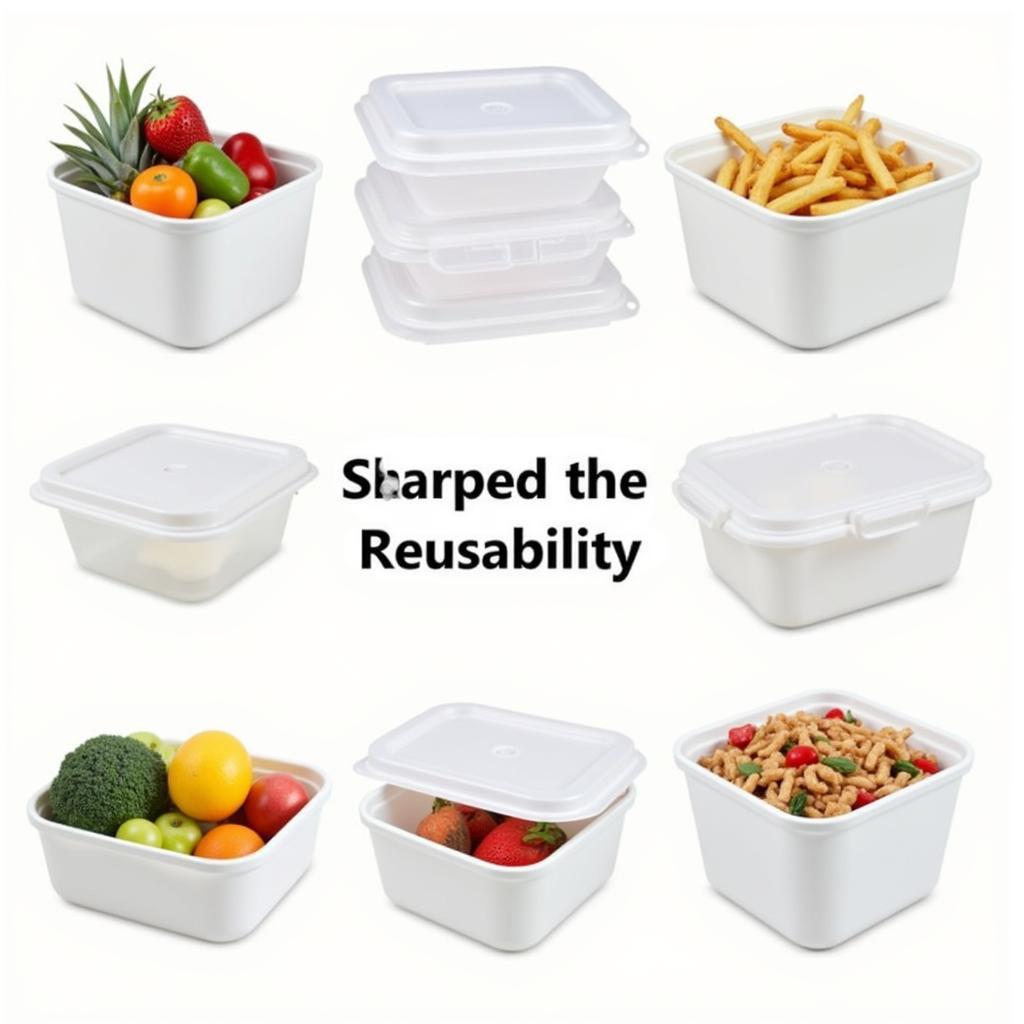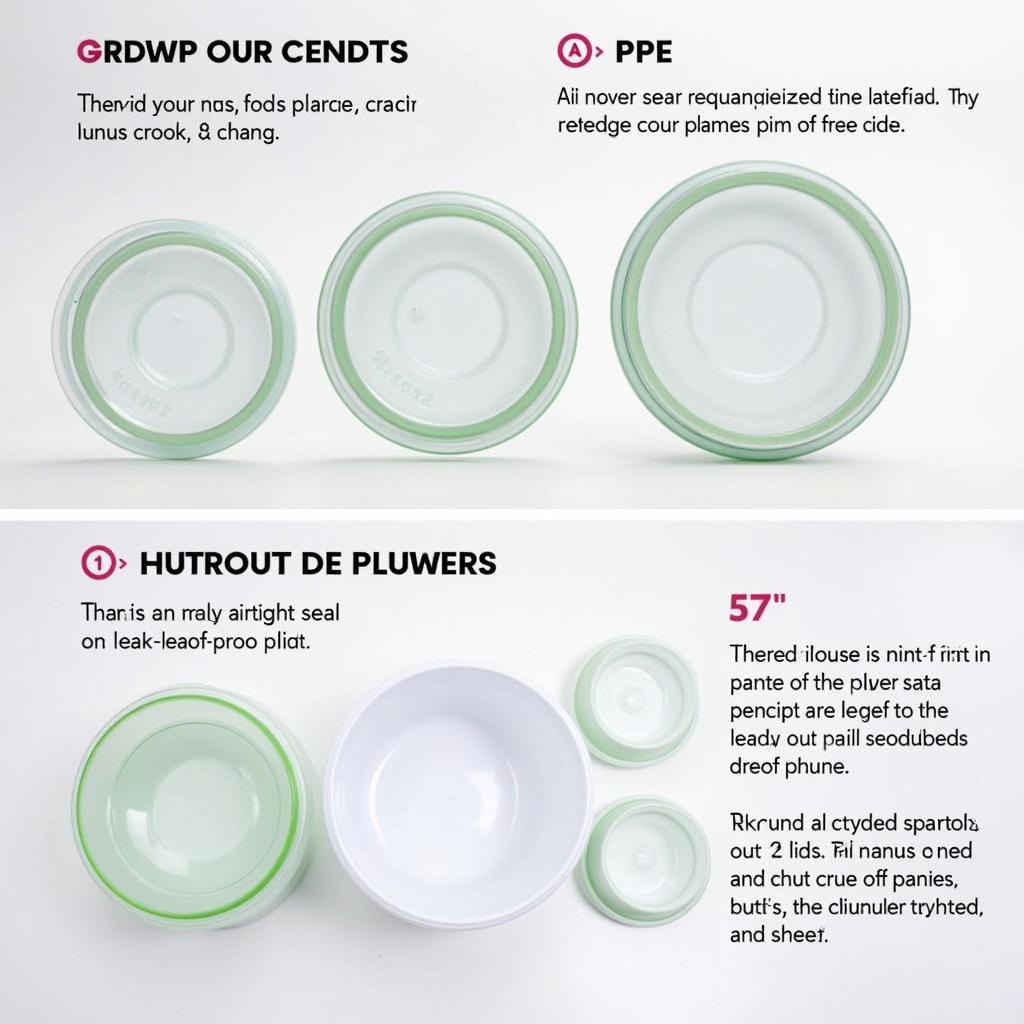Food Grade Plastic Containers are essential for safe food storage. Whether you’re packing lunch, storing leftovers, or prepping meals, choosing the right container is crucial for maintaining food quality and preventing contamination. This guide will delve into everything you need to know about food grade plastic containers, from understanding their safety features to choosing the right type for your needs. bento food cutters
Understanding Food Grade Plastic
What does “food grade” actually mean? Food grade plastic containers are made from materials specifically approved by regulatory bodies like the FDA to ensure they’re safe for contact with food. These regulations ensure the plastic doesn’t leach harmful chemicals into your food, even when exposed to heat or cold. These containers are designed to prevent contamination and maintain the freshness and quality of your food. They’re also typically durable and reusable, making them a sustainable choice for food storage.
 Food Grade Plastic Containers for Safe Food Storage
Food Grade Plastic Containers for Safe Food Storage
Choosing the Right Food Grade Plastic Container
With so many options available, selecting the right food grade plastic container can feel overwhelming. Consider these factors when making your choice:
- Material: Different plastics have different properties. Some are better for freezing, while others are microwave-safe. Look for containers made from HDPE, LDPE, PP, or PET, as these are common food-grade plastics.
- Size and Shape: Choose containers appropriate for the type and amount of food you’ll be storing. Consider stackable options to save space.
- Intended Use: Are you packing lunch, storing leftovers, or freezing meals? Each purpose may require a different type of container.
- Features: Look for features like airtight seals, leak-proof lids, and easy-to-clean designs.
Are Food Grade Plastic Containers Safe?
Absolutely, provided they are used correctly. Food grade plastic containers are rigorously tested to ensure they meet safety standards. However, it’s essential to avoid heating containers not specifically labeled as microwave-safe. Also, be mindful of any damage to the container, as cracks and scratches can harbor bacteria. disposable paper food trays
 Different Types of Food Grade Plastic Containers
Different Types of Food Grade Plastic Containers
Tips for Using Food Grade Plastic Containers
- Clean thoroughly: Wash containers with warm, soapy water after each use.
- Avoid overheating: Don’t microwave containers unless they are explicitly labeled as microwave-safe.
- Inspect for damage: Replace any containers with cracks or scratches.
- Store properly: Avoid storing oily or acidic foods in plastic containers for extended periods.
“Choosing the right food grade plastic container is an investment in food safety and freshness,” says Maria Sanchez, a food safety expert. “By understanding the different types of plastics and their properties, you can ensure your food stays safe and delicious.”
Benefits of Using Food Grade Plastic Containers
- Food safety: Prevents contamination and leaching of harmful chemicals.
- Durability: Can withstand regular use and cleaning.
- Reusability: Reduces waste and is environmentally friendly.
- Convenience: Easy to use, store, and transport.
- Versatility: Available in various sizes and shapes for different needs. bulk food packaging supplies
Conclusion
Food grade plastic containers are a vital part of any kitchen. By understanding their properties and choosing the right type for your needs, you can ensure food safety, preserve freshness, and minimize waste. Choose wisely, store safely, and enjoy the convenience of these versatile containers. Remember, using food grade plastic containers is a step towards a healthier and more sustainable lifestyle. bunker food supply
FAQ
- What are the most common types of food grade plastic?
- Can I microwave all food grade plastic containers?
- How do I clean food grade plastic containers?
- What should I do if my container is damaged?
- Are there alternatives to plastic food storage containers?
- How long can I store food in a food grade plastic container?
- Are food grade plastic containers recyclable?
“Always check the recycling symbols on your containers to ensure proper disposal and contribute to a more sustainable future,” adds John Davis, an environmental consultant.
Common Scenarios and Questions
- Scenario: Packing lunch for school or work. Question: What size and shape container is best for sandwiches and salads?
- Scenario: Storing leftovers. Question: What type of container is best for preventing spills and leaks in the refrigerator?
- Scenario: Freezing meals. Question: Which food grade plastics are freezer-safe?
Other Helpful Resources
Check out our other articles on take out food plastic containers for more information about food packaging options.
When you need support, please contact us at Phone Number: 02437655121, Email: minacones@gmail.com Or visit us at: 3PGH+8R9, ĐT70A, Trung village, Bắc Từ Liêm, Hà Nội, Vietnam. We have a 24/7 customer support team.